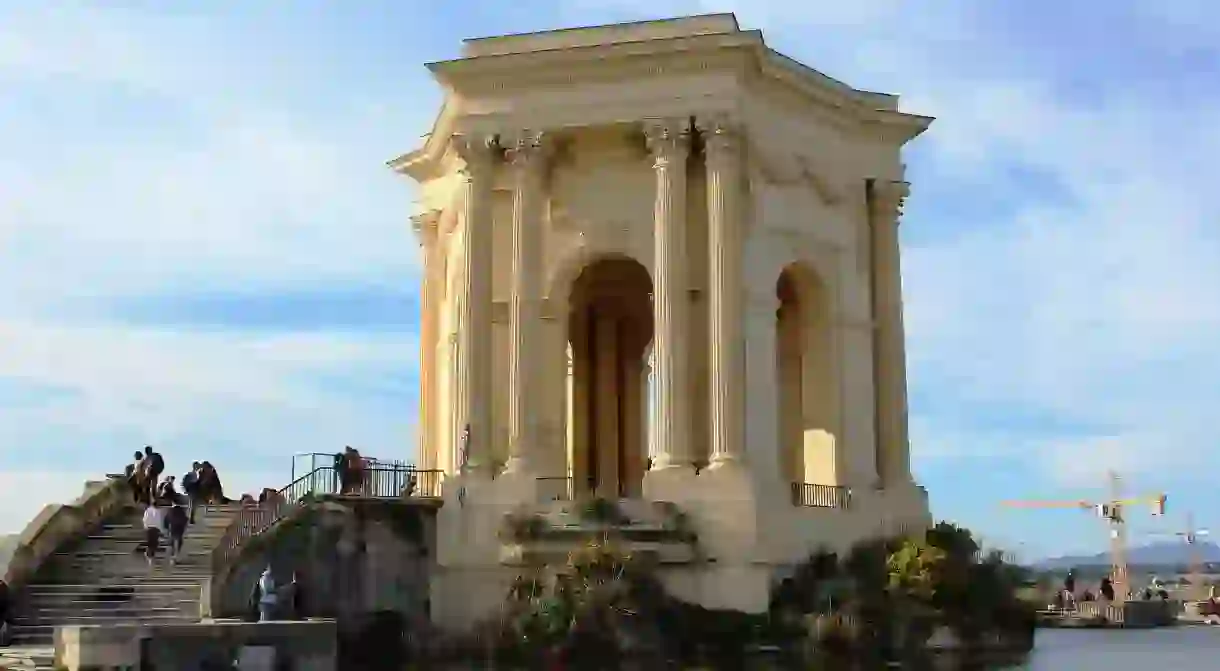A Walking Tour of Montpellier's Architectural Landmarks

Montpellier is the perfect sized city for tourists and visitors to go on a walking tour of the city’s architectural landmarks. Follow this guide to go from its ancient western edge, through the historic centre, and into its new age of design and development on the shores of the River Lez.
Saint-Clément Aqueduct
The Saint-Clément Aqueduct was built in the 18th century by hydraulic engineer Henri Pitot de Launay to supply water to Montpellier. It took 12 years to complete the 14km (8.7 miles) of pipeline and the design itself was inspired by the Pont du Gard in the Occitanie Region. The most notable section of the aqueduct is the double row of Roman-inspired arches—Arceaux.
Nearby
Marché des Arceaux: running alongside the arches of the Arceaux aqueduct, browse the mounds of olives, tomatoes, bread, and more at this local market open Tuesdays and Saturdays from 7 am-1 pm.

Château d’eau
Constructed at the same time as the aqueduct by Henri Pitot is Montpellier’s beautiful water tower. It distributed drinking water from the source of the River Lez and is fed by the aqueduct.
Nearby
Promenade du Peyrou: this expansive esplanade runs from the Château d’eau all the way to Montpellier’s very own Arc De Triomphe. Sundays are market days here, the finest in the city.
Promenade du Peyrou, 230 Place Jacques Mirouze, 34000 Montpellier, France

Arc de Triomphe
Montpellier’s Arc de Trimophe, also known as Port du Peyrou, is the entrance to the Royal Palace of the Peyrou. From the palace and Promenade du Peyrou, visitors can also walk to the Saint-Clément Aqueduct and enjoy the great views over to the east of Montpellier.
This incredible landmark is a monument dedicated to the glory of King Louis XIV of France, the ‘Sun King’. It was designed in 1690 by François d’Orbay—the French architect involved in some of France’s most iconic landmarks—and finished around 1693.
Nearby
Right next to the Arc de Triomphe is Montpellier’s Court of Appeal, another grand building to squeeze into a tour while walking by.

Cathédrale Saint-Pierre
The imposing Cathédrale St-Pierre was commissioned by Pope Urban V in 1364 and was converted into a cathedral in 1536 when the archbishop was transferred from Maguelone to Montpellier. It was nicknamed ‘Fort St. Peter’ during the Wars of Religion in the 16th century due to its fortress-like structure. The Faculty of Medicine, housed in the former cloister of the monastery of Saint-Benoît, lies adjacent.
Nearby
The Musée d’Anatomie can be found in the courtyard and can be explored as part of the guided tours of the Faculty of Medicine organised by the Tourist Office.
Cathédrale St-Pierre, Rue Saint-Pierre, 34000 Montpellier, France, +33 4 67 66 04 12

Place de la Comédie
The Place de la Comédie is one of the largest squares in Europe and a meeting point for locals and tourists alike. From there, head into the old town, towards the train station, or into the new neighbourhood of Antigone. A fountain in the square’s middle called the Three Graces was built by sculptor Étienne d’Antoine in 1790. The Opéra Comédie is notable, here, built in the Italian style and opened in 1888.
Nearby
Plenty to do and see in the heart of Montpellier. But first, a coffee at Nook Café.

Antigone
The neighbourhood of Antigone is the most architecturally-thrilling neighbourhood in Montpellier. It is a dominating area of the city (around 36 hectares) (around 90 acres) that used to be army barracks and was designed almost entirely by one architect: Catalonian Ricardo Bofill. Even though Antigone was established in the 1970s, the wide avenues, imposing squares, and the futuristic-style buildings are still a complete delight in comparison to Montpellier’s old town.
Nearby
A stone’s throw away from the main thoroughfare is the covered market Les Halles Jacques Coeur. Stock up on local produce and regional delicacies.

Hôtel de Région
Finish up the tour on the banks of the River Lez. The impressive neo-classical Hôtel de Région stands proudly overlooking this new neighbourhood government building of the region. Completed in 1989 as the work of Spanish architect Ricardo Bofill, it was designed as glass-clad triumphal arch, a nod to historic architectural forms as well as proudly displaying its modern materials. It was the first building built on the southern side of the River Lez, symbolic of Montpellier’s revival and progress.
Nearby
Take a stroll west along the river for about 25 minutes and come to one of the coolest spots in town: Marché Du Lez. A self-styled epicentre in its own right, it’s filled to the bring with vintage markets, eateries, and artsy types.
Conseil Régional d’Occitanie – Site de Montpellier, 201 Avenue de la Pompignane, 34000 Montpellier, +33 04 67 22 80 00














